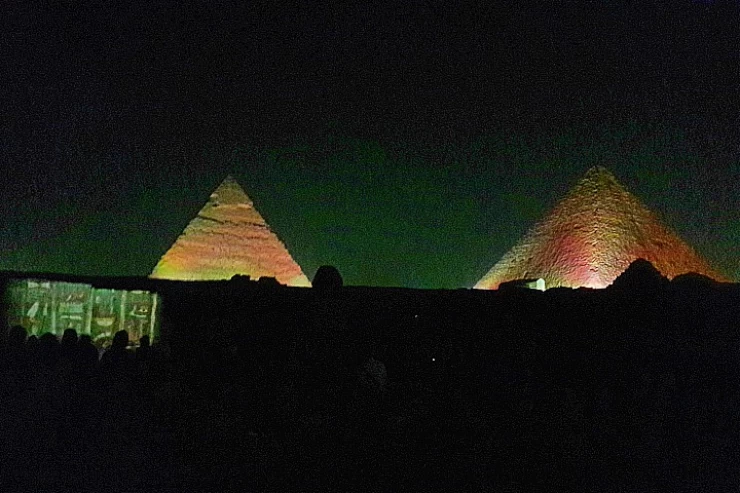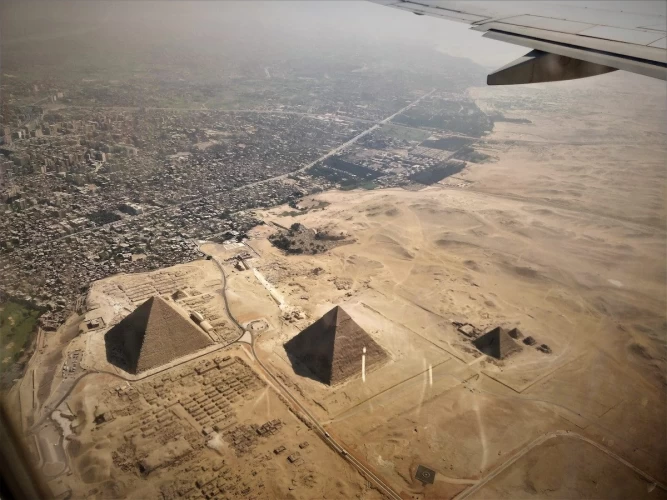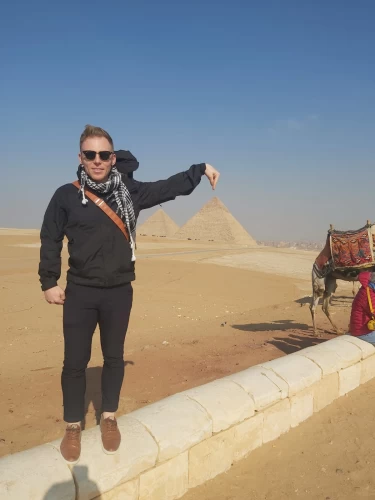
Historia de egipto | Cronología de la historia de Egipto

Debido a la crecida del río Nilo y a sus fértiles riberas y deltas, así como a los logros y el impacto de los pueblos indígenas de Egipto, la historia de este país está repleta de grandes acontecimientos y grandes eventos arqueológicos. La mayor parte de la historia antigua de Egipto seguía siendo un misterio hasta que se descubrió la Piedra de Roseta, que ayudó a descifrar los secretos de los antiguos jeroglíficos egipcios. La Gran Pirámide de Giza es una de las Siete Maravillas del Mundo Antiguo, y la Biblioteca de Alejandría ha sido la única de su clase durante siglos.
La fundación humana en Egipto se remonta al menos al 6000 a. C. cuando el valle del río Nilo fue habitado por primera vez. La antigua civilización egipcia se unió alrededor del 3150 a. C. con la unificación política del Alto y el Bajo Egipto bajo el primer faraón de la Primera Dinastía, Narmer. La dominación egipcia original continuó en su mayor parte hasta la conquista del Imperio aqueménida en el siglo VI a. C.
Prehistoria (antes del 3100 a. C.)
Hay datos de petroglifos a lo largo de las terrazas del Nilo y en los oasis del desierto. En el siglo X aC, una cultura de cazadores-recolectores y pescadores fue renovada por una cultura de molienda de granos. Los cambios climáticos y / o el pastoreo excesivo cerca del 6000 aC comenzaron a secar las tierras de pastoreo de Egipto, formando el Sahara. Los primeros pueblos tribales emigraron al río Nilo, donde formaron una economía agrícola asentada y una comunidad más centralizada.
Alrededor del 6000 a. C., una cultura neolítica arraigada en el valle del Nilo. Durante la era neolítica, varias culturas predinásticas se desarrollaron de forma independiente en el Alto y el Bajo Egipto. La cultura Badari y la sucesor de la serie Naqada se consideran en general precursoras del Egipto dinástico. El sitio más antiguo conocido del Bajo Egipto, Merimda, es anterior al Badariano en unos setecientos años. Las comunidades contemporáneas del Bajo Egipto coexistieron con sus contrapartes del sur durante más de dos mil años, permaneciendo culturalmente distintas, pero manteniendo un contacto frecuente a través del comercio. La evidencia más antigua conocida de inscripciones jeroglíficas egipcias apareció durante el período predinástico en vasijas de cerámica de Naqada III, fechadas alrededor del 3200 a. C.
Antiguo Egipto (3100-332 a. C.)
El rey Menes fundó un reino unificado en 3150 a. C., lo que dio lugar a una serie de dinastías que gobernaron Egipto durante los siguientes tres milenios. La cultura egipcia floreció durante este largo período y siguió siendo distintivamente egipcia en su religión, artes, idioma y costumbres. Las dos primeras dinastías gobernantes de un Egipto unificado prepararon el escenario para el período del Imperio Antiguo (c. 2700-2200 a. C.), que construyó muchas pirámides, entre las que destaca la pirámide de Djoser de la Tercera Dinastía y las pirámides de Giza de la Cuarta Dinastía.
El primer período intermedio comenzó en una época de agitación política hace casi 150 años. La estabilidad del gobierno restauró la prosperidad del país en el Reino Medio en 2040 a. C. y alcanzó su punto culminante durante el reinado del faraón Amenemhat III. Y con la entrada en el segundo período de separación, con la llegada de la primera dinastía extranjera a Egipto, el reino semítico de Hexus. Los invasores hicsos ocuparon la mayor parte del Bajo Egipto alrededor de 1650 a. C. y crearon una nueva capital en Álvarez. Fueron expulsados por la Fuerza del Alto Egipto dirigida por Ahmose I, quien fundó la Dinastía XVIII y trasladó la capital de Memphis a Tebas.
El estado moderno (circa 1550-1070 a. C.) comenzó con la dinastía XVIII, lo que indica el surgimiento de Egipto como potencia mundial que se expandió durante su mayor extensión a un imperio tan al sur como Tombus en Nubia, e incluyó partes del Levante en el este. Este período fue indicado para algunos de los faraones más famosos, incluidos Hatshepsut, Tutmosis III, Akhenaton y su esposa Nefertiti y Tutankhamon y Ramsés II. La primera expresión históricamente aclamada del monoteísmo se produjo durante este período como Atenismo, aunque algunos consideran el Atenismo una forma de monoteísmo en lugar de monoteísmo. Los contactos repetidos con otros países trajeron nuevas ideas al nuevo reino. Más tarde, el país fue invadido y ocupado por libios, libios y asirios, pero los egipcios indígenas finalmente los expulsaron y recuperaron el control de su país.
En el 332 a. C., el gobernante macedonio Alejandro el Grande conquistó Egipto cuando derrocó a los aqueménidas y estableció el reino helenístico ptolemaico, cuyo primer gobernante fue uno de los ex generales de Alejandro, Ptolomeo I Soter. Los Ptolomeos tuvieron que luchar contra las rebeliones nativas y se vieron envueltos en guerras civiles y extranjeras que llevaron al declive del reino y su anexión final por Roma. La muerte de Cleopatra puso fin a la independencia nominal de Egipto, lo que provocó que Egipto se convirtiera en una de las provincias del Imperio Romano.
El dominio romano en Egipto (incluido el bizantino) duró desde el 30 a. C. hasta el 641 d. C., con un breve intervalo de control por parte del Imperio Sasánida entre 619 y 629, conocido como Egipto Sasánida. Después de la conquista musulmana de Egipto, partes de Egipto se convirtieron en provincias de sucesivos califatos y otras dinastías musulmanas: califato de Rashidun (632-661), califato omeya (661-750), califato abasí (750-935), califato fatimí (909-1171) ), El sultanato ayubí (1171-1260) y el sultanato mameluco (1250-1517). En 1517, el sultán otomano Selim I capturó El Cairo, absorbiendo Egipto en el Imperio Otomano.
Egipto permaneció completamente otomano hasta 1867, sin embargo durante el control francés de 1798 a 1801. Inaugurado en 1867, Egipto se convirtió en un país tributario autosuficiente llamado Khedifa Misr. Pero, Khadift Egypt cayó bajo la administración británica en 1882 a raíz de la guerra anglo-egipcia. Tras el final de la Primera Guerra Mundial y tras la revolución egipcia de 1919, se estableció el Reino de Egipto. Si bien el Reino Unido es un estado independiente de jure, conserva el control sobre los asuntos exteriores, la defensa y otros asuntos. La ocupación británica continuó hasta 1954, con la aprobación del anglo-egipcio en 1954.
Con la retirada completa de las fuerzas británicas del Canal de Suez en 1956 d.C., la moderna República de Egipto fue fundada en 1953 d.C., esta fue la primera vez en 2500 años que Egipto fue completamente independiente y gobernado por los egipcios originales. El presidente Gamal Abdel Nasser (presidente Ali Egypt de 1956 a 1970) introdujo varias reformas y estableció la República Árabe Unida de corta duración con Siria. Sus términos también vieron la Guerra de los Seis Días y la creación del Movimiento Internacional de Países No Alineados. Su sucesor Anwar Sadat (presidente de 1970 a 1981) cambió el rumbo de Egipto, alejándose de muchos principios políticos y económicos de Nasiriyah, restableciendo un sistema multipartidista y lanzando la política de apertura económica. Dirigió Egipto en la Guerra de Yom Kippur de 1973 para restaurar la Península del Sinaí en Egipto, que Israel había ocupado desde la Guerra de los Seis Días en 1967. Esto posteriormente condujo al tratado de paz entre Egipto e Israel.
La historia egipcia reciente ha estado dominada por los acontecimientos que siguieron a casi treinta años de gobierno del ex presidente Hosni Mubarak. La revolución egipcia de 2011 derrocó a Mubarak y resultó en el primer presidente elegido democráticamente en la historia de Egipto. Los disturbios después de la revolución de 2011 y las disputas relacionadas llevaron al golpe de Egipto de 2013.
La historia del antiguo Egipto se extiende desde los primeros asentamientos prehistóricos del norte del valle del Nilo hasta la conquista romana en el año 30 a.C. La historia de la era faraónica se remonta al 3200 a.C., cuando el Alto y el Bajo Egipto se convirtieron en un estado coherente hasta que el país cayó bajo el dominio griego en el 332 a.C.
las atracciones en Egipto se puede hacer durante uno de los viajes de lujo de Egipto que le permite permanecer en los hoteles más destacados y cruceros por el Nilo o si usted está viajando con una pequeña cantidad de dinero y le gustaría ahorrar su tiempo y los gastos que usted puede comprobar nuestra amplia variedad de paquetes de viajes baratos de Egipto, si usted ha estado en un accidente y sufren de una lesión física no se preocupe nunca porque nuestros operadores profesionales personalizados una colección de paquetes de viajes accesibles en silla de ruedas de Egipto que utilizan todos los vehículos accesibles y diferentes instalaciones para las personas con discapacidad que es una de las principales categorías de nuestros viajes clásicos de Egipto.
Un experto de Cairo Top Tours, especializado en egiptología y que habla su idioma, le asistirá allí donde lo necesite.
The ancient history that can be perceived from the Pharaohs has to be one of the greatest historical civilizations ever. Its events’ timeline is well over five thousand years, and many aspects of the world, such as art, architecture, culture, and even religion, have their bases in Egypt. The records of the land of Egypt are interesting in that they contain histories of empires that were built and then perished, histories of great kings and queens, and outstanding places and structures that even today, in modern societies, can only marvel at. Egypt’s history is undoubtedly dominated by a vibrant narrative of struggle, hope, and ingenuity of the people portrayed, from the making of the pyramids to the currents of the Nile.
The Ancient Kingdoms of Egypt (c. 3100 BC–332 BC)
1. Pre-Dynastic Period (Before 3100 BC)
The elements of history written of Egypt are dated around 3100 BC, but if one avails of its importance in terms of history, it dates back even to the pre-dynastic era, when there was the emergence of small agricultural settlements along the Nile. By this time, the early residents of Egypt were busy establishing forms of agriculture as well as animal husbandry, pottery making, and the making of crude tools. These settlements served as the foundation of the elaborate systems of culture and society that were to come.
2. The Unification and Early Dynastic Period (c. 3100–2686 BC)
King Narmer, often referred to as Menes was responsible for the unification of Upper and Lower Egypt, which signified the onset of ancient Egyptian civilization. He is considered to be the first pharaoh of Egypt and founded the nation’s first dynasty. This unifying act was essential since it created the nucleus around which the centralized monarchy of Egypt, which was the prevailing system of government for almost three thousand years, would revolve.
Towards the tail end of the Early Dynastic, the very first steps in the construction of monumental architecture began, and hieroglyphs were mastered. It was in this period that the rulers were expected to fulfill the role of the king and also that of a god. This idea existed for many years and was a fundamental one in Egypt.
3. The Old Kingdom (c. 2686–2181 BC)
The divine rulers, who were the Pharaohs in the earthly realm, tamed every resource and manpower to erect huge structures such as the Great Pyramid of Khufu and the Sphinx.
The Old Kingdom period displayed a clear and consistent administrative hierarchy and even a large-scale institutional support system that controlled the resources, agricultural production, and the temples of the state. However, in the latter years of this era, the dominant position of the central authority began to diminish, ushering in an era of chaos and fragmentation.
4. The Middle Kingdom (c. 2055–1650 BC)
Following the tumultuous First Intermediate Period referred to, Egypt returned to political stability and strong rulers in its Middle Kingdom. There is a revival in this period in the fields of art, literature, and monumental building works. Pharaohs such as Mentuhotep 11 and Senusret 111 were responsible for extending Egypt’s boundaries southward into Nubia as well as promoting relations with other countries through trade.
The Middle Kingdom is usually regarded as the classical period of ancient Egypt, filled with relative calm and wealth. The authorities emphasized the development of construction and the growth of the economy of Egypt. In spite of such achievements, the internal conflicts and external challenges finally caused the disintegration of the Middle Kingdom, making way for another period of darkness and despair.
5. The New Kingdom (c. 1550–1070 BC)
The new kingdom constitutes, also from a chronological point of view, the culminating era of ancient Egyptian civilization. It was during this period that Egypt was transformed into a full-fledged empire under rulers such as Thutmose III, Hatusu, and Rameses II, who through wars and conquests, or rather political strategies, expanded Egypt's borders. He also added great temples during this period, such as those at Karnak, Luxor, and Abu Simbel, many of which still exist today.
Il nuovo regno era un’epoca che riformò anche la religione in notevoli modi, come il periodo di regno del faraone Akhenaten, which introduced a period of continuous fight in worshipping a single god—Aten, the disk of the sun. His was, however, an unpopular and a very brief rule, for there were leaders after him who brought back the old ways of worship in Egypt, which was worshiping none but many gods.
But then, power aside, Egypt was not immune to the laws of history. By the close of the New Kingdom, this state institution in question was already wobbly, and there was a gradual abatement of its activities.
1. The Ptolemaic Dynasty (332–30 BC)
For many centuries, the old state of Egypt thrived free until that point in time, which altered when the rule of Alexander the Great started in the year 332 BC. It was also during those years that Alexandria became the center of Greek civilization and education, with the noted Library of Alexandria and the Lighthouse, which is now one of the Seven Wonders of the Ancient World.
Until the end of the dynasty, the traditions of Egypt were largely maintained, even though the rulers were Hellenistic kings. The last ruler of this dynasty, Cleopatra VII, was known to have opposed the domination of Rome by trying to establish relations with Julius Caesar and Mark Antony. However, after her loss at the Battle of Actium in 31 BC, Egypt fell into the Roman Empire.
Under the control of the Romans, Egypt was considered one of the most valuable provinces of the empire, primarily because it was rich and produced plenty of crops, particularly grains. The Romans maintained several of the practices of the Ptolemaic kings; however, Egypt was administered as a colony of the empire. The establishment of Christianity in Egypt started during the Roman times, and it was in the 4th century A.D. that Egypt began to develop into a significant early center of Christianity.
The phase change from the Roman to the Byzantine Empire that occurred in 395 AD marked the slow deterioration of Egypt’s economic well-being, but Egypt was still geographically and religiously active. It was also in this time period that the popular Coptic Church was born, which incorporated aspects of Christianity with ancient Egyptian beliefs.
The Egyptian territories fell to the Army of Islam in the year 642 AD. This marked the commencement of the Islamic Era in Egypt. As Cairo, a city created by the Fatimids in 969 AD, grew prominent, it was clear that Egypt was going to become one of the most pivotal countries in the Islamic world. After most of the Egyptian lands were conquered, Egypt witnessed great prosperity in learning, trade, and the arts.
The Fatimids, Ayyubids, and Mamluks
The capital of Egypt was established, and the famous Al-Azhar University was built during the reign of the Fatimid Dynasty which ruled over Egypt. With the waning of the Fatimid era, Egypt was captured for a brief period by the fact that Saladin, protector of the territories, including Egypt himself, later founded the Ayyubid dynasty, whose main task was fighting against the Crusaders.
Later came the Mamluks, who were a military caste and who ruled over Egypt for several eras. They built a number of the most beautiful structures in the city, including mosques, schools, and fortifications, in the Mamluk period. Egypt was, at least at the stage when it was defeated, a rather big country with advanced development before it was conquered by the Ottoman Empire.
Egypt in the Modern Era (1517–Present)
1. Ottoman and British Rule
With the Ottoman Empire's conquest in 1517, Egypt was annexed as part of the empire for nearly four hundred years and had remained so bound. That is primarily due to its geopolitical possibilities; it was invaded several times by European powers, and in 1798 Napoleon Bonaparte managed to invade Egypt for a short period. After the French lost in this region, Egypt was ruled by Muhammad Ali Pasha, who was on modern Egypt’s compass. He reformed agriculture, industry, and the military; these transformations served as the waking up of the modern state of Egypt.
In the late nineteenth century, Egypt acquired the status of a British protectorate, which lasted until ’52, the year Egypt resumed control after a revolution led by Gamal Abdel Nasser. It was Nasser who became one of the most powerful figures within the Arab sphere of influence, propagating pan-Arabism and earlier nationalizing the Suez Canal in 1956.


















